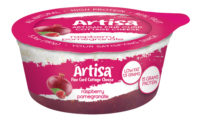Cottage Cheese Indoors

And while closed vats have been standard equipment for natural cheesemakers for years, cottage cheese makers have only recently begun to embrace enclosed vats.
In addition to the aforementioned hygiene advantages, and the capabilities for CIP, some process advantages have also been discovered.
In the past 18 months, two companies have introduced automated enclosed vats designed specifically for cottage cheese. But the sticking point was assuring the same level of cheese quality while adding the automation.
"Conventional wisdom in cottage cheese making has been that you can't get the required curd particle distribution with an enclosed vat," says George Schwinghammer, sales mgr. with Scherping Systems, Winsted, Minn. "We had kind of understood that. But then we went and purchased a number of retail available cottage cheese products from different plants, and we found that we could provide a product that was as good as what was evident in what we purchased. We really felt it should be a do-able deal."
Schwinghammer said a few tests in university pilot plants with dual horizontal agitators confirmed what the Scherping engineers suspected.
"We were able to make cottage cheese that had a very similar characteristic to what was available on the commercial market."
Schwinghammer says earlier attempts at an enclosed vat for cottage cheese often resulted in a high level of fines being lost in the whey. This was overcome by paying particular attention to the design of the dual agitators and the shape of the vessel when Scherping designed its Horizontal Cottage Cheese Vat (HCCV).
The HCCV was introduced by Scherping at last fall's Worldwide Food Expo, in Chicago.
The fully-automated, completely CIP-able machine allows cottage cheese makers uniform process control for a more consistent product, the company says.
The HCCV can reduce production time, reduce fines and allow for optimum curd suspension, due in part to a design which features counter rotating dual agitators. The enclosed vat also offers a coagulation sensor and a pH monitor.
Tetra Pak, Vernon Hills, Ill., offers its Tetra Tebel O-Vat closed vat system for cottage cheese. The O-Vat is a fully- enclosed hygienic unit with a separate, mechanized cutting and stirring apparatus that provides even, well-distributed curd size. The O-Vat produces as much as a 5% yield gain over open vats, offers fully-automated controls and is completely CIP-able. But it still makes great cheese, says Scott Walls, product mgr., cheese systems at Tetra Pak.
"We've tried to emulate what the cheesemakers do themselves," Walls says. "Our knives are made of wire, so it's very thin and it treats the curd very gently. In the open tank technology they do a radial cut and then a lengthwise cut from one end to the other, and the O-Vat works the same way."
Walls said Tetra Pak began working with USDA in 2002, and by early 2003 the agency approved the product design. The company distributed information on the O-Vat at Worldwide Food Expo, and the new vat is drawing a good deal of interest from processors.
"We've generally had a very good reception," Walls says. "We're in advanced discussions with several major cottage cheese manufacturers in the U.S."
Meanwhile, in the mozzarella arena, one of the more recent developments is a rotary mold chiller (RMC) that allows processors to mold cheese to retail sizes rather than having to mold to a large block size and cut later.
Johnson Industries International, Windsor Wis., offers a machine that can mold at speeds up to 4,000 lbs per hour, says Sullivan Brennan, CEO.
"The results have been outstanding; much higher than we expected, especially as far as yield results," Brennan says. Molding directly to size reduces waste and increases yield by as much as 4%, he says.
"It can run 6, 8, and 12 oz pieces as well as 1-lb rectangular and the traditional 1-lb cylinder soup-can style," Brennan says.
The machines have been available for a little over two years and more than 30 have been sold.
Finally, for big volume, high speed shredding operations, Johnson has introduced a high-speed Quad shredder that can shred and package cheese at phenomenal speeds.
"It actually incorporates four Urschel CC shredders. The shredders and all conveying equipment is at ground level for easy maintenance," Brennan says.
Due to a proprietary control system, there's no jamming of the Urschels, Brennan says. Also, no product hits the floor, there's no dust in the air and no cheese buildup because the unit has no vibrators. The system has a capability of running up to 12,500 lbs per hour.
Looking for a reprint of this article?
From high-res PDFs to custom plaques, order your copy today!









